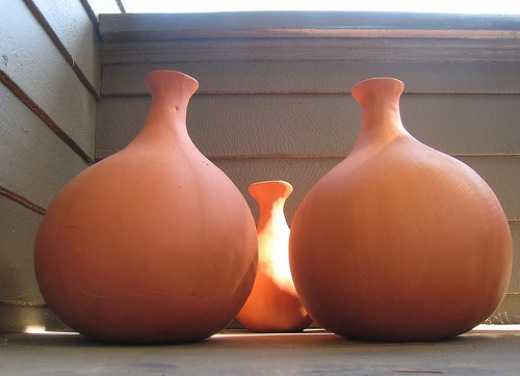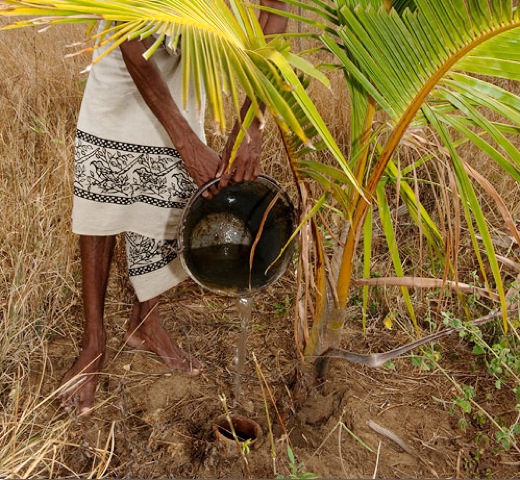 Image above: Clay ollas used for water drip. From (http://sustainableberea.org/blog/quick-garden-tips).
By Sam Grover on 29 September 2010 for TreeHugger.org -
(http://www.treehugger.com/files/2010/09/unglazed-clay-pots-irrigation.php)
There really is very little new under the sun. While TreeHugger likes to rave about high-tech drip irrigation (sometimes aided by wireless soil sensors and open-source garden monitoring systems), many cultures have been perfecting more efficient, labor saving irrigation systems for centuries. In fact, unglazed terracotta pots have been used for over 4000 years to create slow release watering systems. It's a low-impact, affordable technique that might have some relevance for drought-stricken communities today.
Kevin Bayuk of the Permaculture Research Institute of Australia has a great overview of the use of "olla" terracotta pots for irrigation (http://permaculture.org.au/2010/09/16/ollas-unglazed-clay-pots-for-garden-irrigation). Thought to have originated in Northern Africa, and with evidence of similar systems in China that date as far back as 4000 years, the olla is undoubtedly an enduring idea. And like many of the best ideas, it is simple and easy to implement.
Image above: Clay ollas used for water drip. From (http://sustainableberea.org/blog/quick-garden-tips).
By Sam Grover on 29 September 2010 for TreeHugger.org -
(http://www.treehugger.com/files/2010/09/unglazed-clay-pots-irrigation.php)
There really is very little new under the sun. While TreeHugger likes to rave about high-tech drip irrigation (sometimes aided by wireless soil sensors and open-source garden monitoring systems), many cultures have been perfecting more efficient, labor saving irrigation systems for centuries. In fact, unglazed terracotta pots have been used for over 4000 years to create slow release watering systems. It's a low-impact, affordable technique that might have some relevance for drought-stricken communities today.
Kevin Bayuk of the Permaculture Research Institute of Australia has a great overview of the use of "olla" terracotta pots for irrigation (http://permaculture.org.au/2010/09/16/ollas-unglazed-clay-pots-for-garden-irrigation). Thought to have originated in Northern Africa, and with evidence of similar systems in China that date as far back as 4000 years, the olla is undoubtedly an enduring idea. And like many of the best ideas, it is simple and easy to implement.
Image above: Sri Lankan farmer refills buried olla watering coconut tree. From article.
According to Bayuk, ollas take advantage of the microporous nature of unglazed terracotta pots. This means they do not simply allow water to seep out of them freely, but rather guide seepage from them in the direction where suction develops. Because plants wick moisture from the soil, their roots creates soil moisture tension that only pulls water from the pot when it is most needed. The result, says Bayuk, can be as much as 50-70% water savings, as well as decreased labor. Manufacturing ollas also offers an ideal opportunity for creating sustainable, local micro-businesses in rural areas.
Bayuk goes on to explain how ollas can be used in your average garden, and gives some tips for optimal performance. It's important, for example, to ensure that the pot remains at least half-full, otherwise moisture flow can be impacted by a build up of salt residues. He also offers up some great videos on how ollas are made, including the example from Ingleton Pottery below, and gives a rundown of some of the research regarding optimal size, shape and materials for manufacturing olla irrigation pots.
It's all good stuff. And not a wireless soil sensor in sight.
.
No comments :
Post a Comment